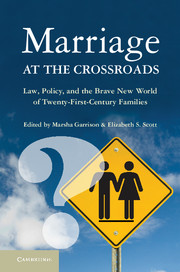Book contents
- Frontmatter
- Contents
- Contributors
- Acknowledgments
- Introduction
- Part I History, Demographics, and Economics – Multiple Perspectives on Families
- Part II Empirical Research on Family Change
- Part III Family Policy and Law for the Twenty-First Century
- Comments
- 14 The Growing Diversity of Two-Parent Families
- 15 Legal Regulation of Twenty-First-Century Families
- Index
- References
15 - Legal Regulation of Twenty-First-Century Families
Published online by Cambridge University Press: 05 November 2012
- Frontmatter
- Contents
- Contributors
- Acknowledgments
- Introduction
- Part I History, Demographics, and Economics – Multiple Perspectives on Families
- Part II Empirical Research on Family Change
- Part III Family Policy and Law for the Twenty-First Century
- Comments
- 14 The Growing Diversity of Two-Parent Families
- 15 Legal Regulation of Twenty-First-Century Families
- Index
- References
Summary
A primary theme of this volume is that recent sweeping changes in marriage and family life present important challenges for family law. Half a century ago, both law and deeply entrenched social norms prescribed marriage as the only acceptable family form. Marriage was exclusively heterosexual, and both marital roles and entitlements were based on spousal gender. As the various contributors to this volume have explained, much has changed. Across most of the industrialized world, the proportion of families based on marriage has declined substantially. Increasingly, couples choose to live together before marriage or as an alternative to marriage. A 2011 survey found that barely 50 percent of American adults were married – a record low (Pew 2011). A growing number of children are born to unmarried mothers, who often live in informal unions with their children's fathers. As a result of higher divorce rates and the dissolution of nonmarital families, many more children live in a succession of households involving a single parent, that parent's new partner, and, sometimes, the children of the partner or of the parent and the new partner. Same-sex couples also form families and raise children today in a way that was uncommon fifty years ago and, increasingly, these couples have been successful in advocating for legal recognition of their unions.
Several contributors describe how the institution of marriage itself has changed dramatically over the past half-century. Differentiated social roles for husband and wife are no longer prescribed in the way that they once were, and the law has taken a strong stand in support of gender equality (Goldberg, Chapter 11). The new equality norm is associated with increasing equality in spousal earnings and a somewhat more egalitarian apportionment of household work (Brinig, Chapter 3). Moreover, the meaning of marriage has evolved from a role-based, “institutional” model to one based on companionship or, more recently, individual personal fulfillment (Amato, Chapter 6). Under modern divorce law, spouses have unprecedented freedom to leave unhappy marriages, and public opinion increasingly favors such freedom (Schneider, Chapter 12).
- Type
- Chapter
- Information
- Marriage at the CrossroadsLaw, Policy, and the Brave New World of Twenty-First-Century Families, pp. 303 - 326Publisher: Cambridge University PressPrint publication year: 2012
References
- 2
- Cited by



